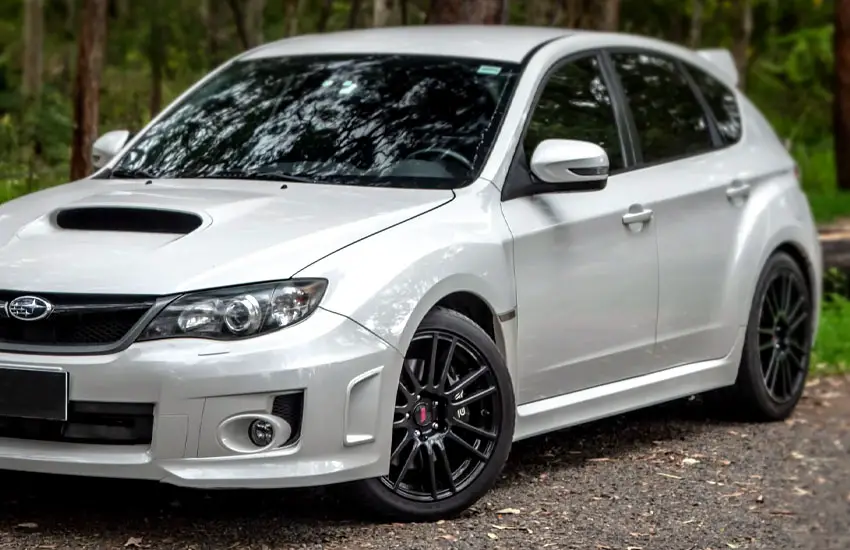As an Amazon Associate, I earn from qualifying purchases at no extra cost to you.
Subaru ‘AT Oil Temp’ Light Blinking: Let’s Fix It Together
Have you ever been driving your Subaru and suddenly noticed a mysterious warning light on the dashboard? It can be a bit stressful, especially if you’re not sure what it means. Don’t worry, though! We’re here to break down three of the most common Subaru warning lights—the brake warning light, traction control warning light, and AT oil temp light—so you can understand what they really mean and what to do when they pop up.
Understanding these warning lights is super important. They're like little messengers from your car, telling you when something's up, whether it's something small or more serious. Don't let them freak you out! By the end of this post, you’ll be able to tackle these issues with confidence. Let’s dive in!

What the Brake Warning Light Means and How to Fix It
When your Subaru's brake warning light comes on, it's like the car is sending out an urgent text that says, “Hey, pay attention to me!” It can happen for a few reasons, and not all of them are cause for panic. Let’s break down what it really means and how you should handle it.
Why the Brake Warning Light Comes On
One of the first things to know is that your brake system is one of the most vital parts of your car. It's responsible for keeping you safe on the road. So when that warning light shows up, it's not something to ignore.
There are a few common reasons why this light might appear:
- Parking Brake Engaged: This is the simplest explanation. If you've left the parking brake on by accident, the light will turn on. Sometimes we forget we're parked on a hill, and the brake light gives us a friendly reminder.
- Low Brake Fluid: Brake fluid helps transfer the force from your foot to the brakes. If your brake fluid level is low, it can affect your braking ability. Low fluid can happen over time, especially if there's a small leak somewhere in the system.
- Worn Brake Pads: Over time, your brake pads wear down due to friction. When they're too worn, they can't perform their job properly, which can trigger the warning light.
- Brake System Malfunction: If there's an issue with your brake master cylinder, brake lines, or other important parts, this will cause the warning light to come on.
What to Do When the Brake Light Turns On
When the brake warning light turns on, the first thing you should do is check if the parking brake is engaged. If it is, simply releasing it should make the light go off. If that's not the issue, here's what you should do next:
- Check Brake Fluid: Open the hood and check your brake fluid level. If it's low, top it up with the correct type of brake fluid. But if the fluid is dirty or discolored, it's time to change it.
- Inspect the Brakes: If you're due for a brake inspection, it's a good idea to check your brake pads. Worn pads can cause the light to come on, and if they're thin, it's time to replace them.
- Seek Professional Help: If the brake warning light stays on after you’ve checked the basics, it's time to bring your Subaru to a mechanic. A professional will be able to inspect the brake system and identify any hidden issues.
Tips for Preventing Brake Issues
To keep your brakes in tip-top shape, consider these tips:
- Regular Brake Inspections: Have your brakes checked regularly to avoid unexpected issues.
- Use the Parking Brake Properly: Make sure you’re not leaving the parking brake engaged when driving.
- Avoid Overloading Your Vehicle: Heavy loads can put extra strain on your brakes.
By staying on top of these things, you’ll be able to avoid brake problems and keep your Subaru safe on the road.
What the Traction Control Warning Light Means and How to Handle It
Now, let's talk about the traction control warning light. If you’ve ever driven your Subaru on a slippery road, you’ve probably noticed this light flickering on and off. But what does it mean when it stays on? Let's break it down.
Why the Traction Control Light Comes On
Traction control is designed to help prevent wheel spin when driving in slippery conditions. If your Subaru's traction control light comes on, it's letting you know that something’s up with the system. Here are a few common reasons why it could turn on:
- Slippery Conditions: When the road is wet or icy, your tires can start to slip. Traction control kicks in to reduce wheel spin, and this often triggers the light to blink. If the light stays on, there might be an issue with the system.
- Faulty Wheel Speed Sensors: These sensors monitor the speed of each wheel and send the information to the traction control system. If they're faulty or damaged, the system can't function properly, which may cause the light to stay on.
- ABS Issues: Traction control is closely linked to the ABS (Anti-lock Braking System). If there's a malfunction in the ABS, the traction control system can be affected too, triggering the warning light.
- Worn-Out Tires: If your tires are worn down unevenly or are mismatched, this can confuse the traction control system and cause the light to come on.
What to Do When the Traction Control Light Is On
When the traction control light comes on, follow these steps:
- Check for Slippery Conditions: If the weather is bad and you've been driving on wet or icy roads, it's probably just the system doing its job. If it goes off once you're on dry ground, there's nothing to worry about.
- Inspect Your Tires: If the light stays on, check your tires. Look for uneven wear, mismatched tire sizes, or low tire pressure, which could be causing the issue.
- Get the System Checked: If the light remains on and there's no obvious cause, it's time to get your Subaru checked out by a professional. They'll inspect the wheel speed sensors, ABS, and other systems to identify the problem.
Tips to Keep Traction Control Running Smoothly
To avoid issues with your traction control system, consider these tips:
- Check Tire Pressure Regularly: Make sure your tires are inflated to the recommended levels.
- Rotate Tires Regularly: Keep your tires in good shape by rotating them as recommended.
- Drive Carefully in Slippery Conditions: Avoid aggressive driving when it's wet or icy to give your traction control system a break.
By keeping your traction control system well-maintained, you can improve your car's stability and performance, especially in challenging road conditions.
Understanding the AT Oil Temp Light and What to Do About It
The AT oil temp light is one of those lights you really don't want to see come on, but it's also a pretty important one. This light is all about your Subaru's transmission, and when it turns on, it means the transmission is getting too hot. Here's everything you need to know about it.
Why the AT Oil Temp Light Comes On
Transmission fluid is like the lifeblood of your car's transmission. It lubricates the parts, prevents overheating, and ensures smooth shifting. If the fluid gets too hot, it can cause serious damage to the transmission. Here's why the AT oil temp light might come on:
- Low AT Fluid Levels: If your transmission fluid is low, it can cause the system to overheat. Low fluid levels might be the result of a leak or regular wear and tear.
- Overheating Due to Heavy Driving: If you’re towing a heavy load, driving up steep hills, or just driving in stop-and-go traffic, the transmission can overheat. This is more common in hot weather conditions or if you’re pushing your Subaru hard.
- Faulty Transmission Cooling System: If your transmission cooler or cooler lines are clogged or damaged, the fluid won't be able to cool down properly, leading to overheating.
- Contaminated Fluid: If your transmission fluid is dirty or old, it won't cool the transmission as effectively, and the fluid can overheat.
What to Do When the AT Oil Temp Light Comes On
When the AT oil temp light comes on, you should take immediate action. Here’s what to do:
- Pull Over Safely: If you're driving and the light comes on, pull over to a safe location as soon as you can. Turn off the engine and let the transmission cool down.
- Check Fluid Levels: After the car has cooled, check the transmission fluid level. If it’s low, top it up with the correct fluid type.
- Have the Transmission Inspected: If the light stays on after you've topped up the fluid, there could be a bigger problem with your transmission. It's important to have it checked by a professional to avoid long-term damage.
How to Keep Your Transmission Cool
To prevent the AT oil temp light from coming on in the future, try these tips:
- Change Transmission Fluid Regularly: Fresh fluid helps the transmission run cooler and more efficiently.
- Be Mindful of Towing: Don't overload your Subaru or tow heavy loads for long distances.
- Check the Transmission Cooling System: Make sure the cooler and lines are in good condition to help prevent overheating.
By keeping your transmission healthy and fluid levels in check, you'll be able to keep your Subaru running smoothly for many years.
I hope this guide helps you understand what the brake, traction control, and AT oil temp warning lights mean in your Subaru. Don't panic when you see them, but make sure to take quick action so your car stays safe and in great shape. Regular maintenance is key to keeping those warning lights off for good. Stay safe and happy driving!
Frequently Asked Questions
Is it normal for the brake warning light to come on during winter?
Yes, it's common for brake systems to get more wear in cold weather. If the fluid is low or the system is stressed by driving conditions, the light might come on.
Can I still drive my Subaru if the traction control light comes on?
If the light is just flickering, it's okay. However, if it stays on, it's best to get your Subaru checked out to make sure the system is working correctly.
Do I need to replace my transmission fluid if the AT oil temp light comes on?
If the fluid is low or dirty, topping it up or replacing it may help. However, if the light stays on, it's important to have the transmission inspected by a mechanic.
Is it safe to drive with the brake warning light on?
It's not recommended. Driving with the brake warning light on could indicate a serious issue with your brake system. It's best to get it checked as soon as possible.
Can I fix the traction control system myself?
In most cases, traction control issues require professional diagnosis. It’s usually best to let a mechanic check out the wheel sensors and ABS system.
Do I need to stop driving if the AT oil temp light comes on?
Yes, you should pull over and let the transmission cool down. Continuing to drive with overheated transmission fluid could cause serious damage.
Is it okay to ignore the brake warning light?
Definitely not! The brake system is crucial for your safety, so it's important to address the issue as soon as the brake warning light comes on.
Can I drive with low brake fluid?
It's not safe to drive with low brake fluid. Your braking power could be compromised, which is a serious safety risk. Top up the fluid or have it inspected immediately.


